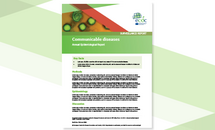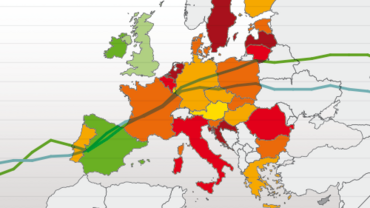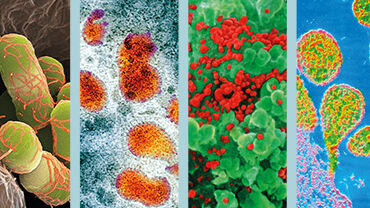Antimicrobial consumption in the EU/EEA (ESAC-Net) - Annual Epidemiological Report for 2022
For 2022, 29 countries (27 European Union (EU) Member States and two European Economic Area (EEA) countries – Iceland and Norway) reported data on antimicrobial consumption. Twenty-seven countries reported consumption data for the community and hospital sectors separately, one country (Cyprus) reported total consumption for both sectors combined, and one country (Germany) reported only community consumption.
Executive Summary
Key facts
- For 2022, 29 countries (27 European Union (EU) Member States and two European Economic Area (EEA) countries – Iceland and Norway) reported data on antimicrobial consumption. Twenty-seven countries reported consumption data for the community and hospital sectors separately, one country (Cyprus) reported total consumption for both sectors combined, and one country (Germany) reported only community consumption.
- Antimicrobial consumption is expressed as the number of defined daily doses (DDD) per 1 000 inhabitants per day. The Anatomical Therapeutic Chemical (ATC) classification index with Defined Daily Doses (DDDs) 2023 was used for the analysis of both 2022 data and historical data.
- The 2022 EU population-weighted mean total (community and hospital sectors combined) consumption of antibacterials for systemic use (ATC group J01) was 19.4 DDD per 1 000 inhabitants per day (country range: 9.1–33.5). While this represents a significant increase in consumption compared to 2020 and 2021, a statistically significant decrease was observed for the EU population-weighted mean consumption over the 10-year period 2013–2022. A statistically significant increasing 10-year trend was observed for two countries (Bulgaria and Cyprus).
- The EU population-weighted mean total consumption of antibacterials for systemic use has decreased by 2.5% since the baseline year of 2019, indicating slow progress towards the EU target reduction of 20% by 2030.
- In 2022, only 10 (36%) countries (nine EU Member States and one EEA country) met or exceeded the EU target of at least 65% of antibiotic consumption being from the ‘Access’ group, as per WHO’s AWaRe classification of antibiotics, by 2030. The number of EU Member States at or above the 65% target has not changed since 2019.
- A statistically significant trend was not detected over the five-year period 2018–2022 for total consumption (community and hospital sectors combined) of antimycotics and antifungals for systemic use (ATC groups J02 and D01B). However, consumption of parenteral amphotericin B (ATC code J02AA01) significantly increased.
Community (primary care sector)
- In the community, the EU/EEA population-weighted mean consumption of antibacterials for systemic use (ATC group J01) was 17.0 DDD per 1 000 inhabitants per day (country range: 8.3–31.2). During the period 2013–2022, a statistically significant decrease was observed for the EU/EEA population-weighted mean overall, and for 11 individual countries. A statistically significant increasing trend was observed for one country (Bulgaria).
- Antibacterial sub-groups with statistically significant decreases in the EU/EEA population-weighted mean consumption within the community during 2013–2022 included: tetracyclines (J01A), cephalosporins and other beta-lactams (J01D), macrolides, lincosamides and streptogramins (J01F), and quinolones (J01M). There was a statistically significant increase in the EU/EEA population-weighted mean for consumption of sulfonamides and trimethoprim (J01E). No statistically significant trends were detected in the EU/EEA population-weighted mean for penicillins (J01C) or other antibacterials (J01X).
- The EU/EEA population-weighted mean ratio of consumption of broad-spectrum penicillins, cephalosporins, macrolides (except erythromycin) and fluoroquinolones to the consumption of narrow-spectrum penicillins, cephalosporins and erythromycin in the community was 4.0 (country range: 0.1–24.7). During the period 2013–2022, a statistically significant increasing trend was observed in the EU/EEA population-weighted mean for this indicator and for nine individual countries. Statistically significant decreasing trends were observed for nine countries.
Hospital sector
- In the hospital sector, the EU/EEA population-weighted mean consumption of antibacterials for systemic use (ATC group J01) was 1.61 DDD per 1 000 inhabitants per day (country range: 0.75–3.15). During the period 2013–2022, a statistically significant decrease was observed at the EU/EEA level. Statistically significant decreasing trends were observed for six countries, and a statistically significant increasing trend was observed for two countries (Bulgaria and Croatia).
- The hospital sector EU/EEA population-weighted mean consumption decreased significantly between 2013 and 2022 for quinolones (J01M) only. Statistically significant increases were observed in the hospital sector for tetracyclines (J01A), sulfonamides and trimethoprim (J01E), and other antibacterials (J01X). No significant EU/EEA trend was detected for consumption of penicillins (J01C), cephalosporins and other beta-lactams (J01D), and macrolides, lincosamides and streptogramins (J01F).
- Of the total consumption of antibacterials for systemic use in the hospital sector, the EU/EEA population-weighted proportion of glycopeptides, third- and fourth-generation cephalosporins, monobactams, carbapenems, fluoroquinolones, polymyxins, piperacillin and enzyme inhibitors, linezolid, tedizolid and daptomycin combined was 37.6% (country range: 17.6–67.5%). During the period 2013–2022, no statistically significant trend for this indicator was observed for the EU/EEA overall. However, eight countries had an increasing trend and one country (Finland) had a decreasing trend in antimicrobial consumption.
- Intensified efforts will be necessary to reach the antimicrobial consumption targets set by the European Council Recommendation on stepping up EU actions to combat antimicrobial resistance in a One Health approach (2023/C 220/01).
- The rebound of total consumption in 2022 and the low number of EU Member States reaching the ‘Access’ target indicate that there will be challenges in reaching the EU antimicrobial consumption targets by 2030.
- For macrolides, lincosamides, and streptogramins (ATC group J01F), the mean consumption rate in the community was statistically significantly higher in 2022 than in 2019. The rise in macrolide consumption in 2022 might be associated with resurgences in respiratory infections, both viral and bacterial, during 2022. Efforts to reduce infections, alongside antimicrobial stewardship, may reduce antimicrobial consumption.
- In the community sector, the ratio of ‘broad’ to ‘narrow’ spectrum antibacterials for systemic use saw a statistically significant increase during the period 2013–2022, with an accelerated rise during 2019–2022.
- In the hospital sector, the percentage of consumption from the ‘Reserve’ group of antibiotics, as per WHO’s AWaRe classification of antibiotics, rose significantly across the EU/EEA during the period 2013–2022, with increasing trends in 17 of 21 countries included in the trend analysis.
Opportunities for action
- Intensified efforts will be necessary to reach the antimicrobial consumption targets set by the European Council Recommendation on stepping up EU actions to combat antimicrobial resistance in a One Health approach (2023/C 220/01).
- The rebound of total consumption in 2022 and the low number of EU Member States reaching the ‘Access’ target indicate that there will be challenges in reaching the EU antimicrobial consumption targets by 2030.
- For macrolides, lincosamides, and streptogramins (ATC group J01F), the mean consumption rate in the community was statistically significantly higher in 2022 than in 2019. The rise in macrolide consumption in 2022 might be associated with resurgences in respiratory infections, both viral and bacterial, during 2022. Efforts to reduce infections, alongside antimicrobial stewardship, may reduce antimicrobial consumption.
- In the community sector, the ratio of ‘broad’ to ‘narrow’ spectrum antibacterials for systemic use saw a statistically significant increase during the period 2013–2022, with an accelerated rise during 2019–2022.
- In the hospital sector, the percentage of consumption from the ‘Reserve’ group of antibiotics, as per WHO’s AWaRe classification of antibiotics, rose significantly across the EU/EEA during the period 2013– 2022, with increasing trends in 17 of 21 countries included in the trend analysis.
* Important note: data were updated using the ATC/DDD Index 2023. Additions and corrections to historical data have also been made since the last Annual Epidemiological Report. Data in this report should therefore not be compared with prior reports. For the most recent data on antimicrobial consumption and trends in EU/EEA countries, readers should refer to the most recent report, or the ESAC-Net interactive database.
Download
Publication data
Data set
Downloadable tables: Antimicrobial consumption - Annual Epidemiological Report for 2022
Downloadable tables: Antimicrobial consumption - Annual Epidemiological Report for 2021








